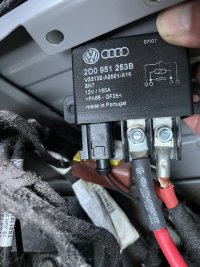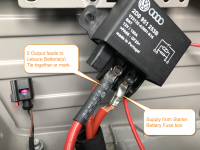It is. N162 relay is the split charge relay.
There is actually three cables, one is out of view. On the left hand side that’s the cable from the engine. The cable on the right hand side with the bare wire showing is one of the leisure battery cables. The other leisure battery cable is behind it. You can just make out a fabric sleeve on the bottom right of that photo. Both leisure battery cables are in that sleeve.
Photo below shows the three cables more clearly. Photo courtesy from a thread from Loz who made a post with instructions and photos showing how to change that split charge relay to a more modern dc-dc controller. Loz might have those speech bubbles the wrong way round. The cables that are together in the sleeve are from the leisure battery’s.
View attachment 139540




















